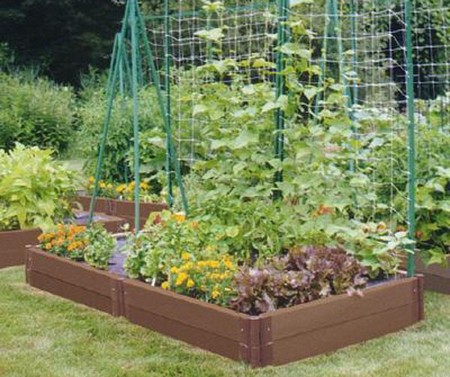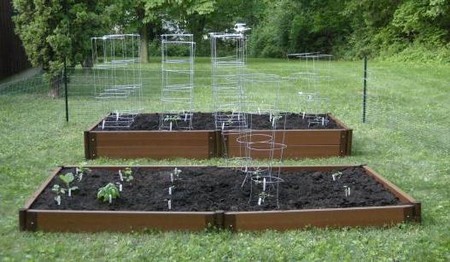Informal raised beds are ideal for bringing ‘height’ to a garden, where they create attractive focal points as well as enabling plants to be grown at waist-height so that they can be easily seen and tended. Once again, they can be surprisingly quick, easy and economical to construct, and they will repay the initial effort with many years of eye-catching service, if planted up and regularly maintained.
This is also a good way to grow rock garden plants in areas where the soil is too acid or exceptionally alkaline – you have to fill the raised bed, so use the soil of your choice.
Economic construction
A cheaper alternative to constructing a raised bed from expensive stones is to use reconstituted stone blocks, railway sleepers or old, strong timbers.
To ensure the long life of a raised bed, it must be soundly constructed; if stones are used, dig trenches 20-30cm (8-12in) where the walls are to be positioned. Form and compact a 5cm thick layer of clean rubble, then lay a 10cm (4m) thick base of concrete. Be sure to leave drainage gaps or holes in the concrete base to enable the bed to drain freely. If railway sleepers are used, the layer of concrete is not needed.
When the walls are complete, fill the inside one-third deep with clean rubble, again, leaving drainage gaps between the stones, then top up with friable, weed-free topsoil. A good depth of soil or growing medium is between 30cm and 45cm, ideally placed over a water-permeable woven plastic membrane that separates it from the layer of drainage rubble. Allow the soil to settle before putting the plants in position. Be prepared to add further soil to ‘top up’ the bed and bring the surface to a level fractionally below the edges.
By restricting a raised bed’s width to 1.5m (5ft) and its height to 60cm (2ft), it is possible to reach all the plants, even from a wheelchair.
Creating height in low raised beds
In order for your raised bed to exert the maximum visual influence on your garden, it must be genuinely ‘raised’. Far too many beds lack impact because they have been set too low in the first place and then planted up unimaginatively.
If you use a combination of tall and low plants in lots of different colors, you can overcome this common problem quickly and easily and create really effective height and color, wherever the bed is positioned. Here is one highly effective arrangement to consider:
Plant a group of two or three small, upright, evergreen conifers such as Juniperus communis ‘Compressa’, 75-90cm (2—3ft) apart. Around these form a sea of lower-growing plants, such as Arabis procurrens ‘Variegata’ (previously known as Arabis ferdinandi-coburgi ‘Variegata’), which is mat-forming with dark green leaves splashed with silver. Thyme creates an impressive background, when used in conjunction with these tall and mat-forming plants; use Thymusserpyllum, in a range of colors from red, through pink to white. Be bold in your selection of colors, for added interest. Additionally, plant Potentilla neumanniana (previously known as P. tabernaemontani, and popularly as spring cinquefoil), with bright yellow flowers.
Categories
Advertisements
Recent Articles
 How to Understand Bed Sizes – A Small Guide
How to Understand Bed Sizes – A Small Guide How to Select Some Must Have Kitchen Accessories
How to Select Some Must Have Kitchen Accessories Best Way to Change a Car Tire
Best Way to Change a Car Tire Best Way to Write an Affirmation
Best Way to Write an Affirmation Best Way to Take Charge of Your Financial Life
Best Way to Take Charge of Your Financial Life Best Way to Survive a Party When You Don’t Know Anyone
Best Way to Survive a Party When You Don’t Know Anyone Best Way to Stop Self Sabotaging Yourself
Best Way to Stop Self Sabotaging Yourself Best Way to Start Journal Writing
Best Way to Start Journal Writing Best Way to Speak with a Powerful Voice
Best Way to Speak with a Powerful Voice Best Way to Simplify Your Life
Best Way to Simplify Your Life Best Way to Respond to a Put-Down
Best Way to Respond to a Put-Down Best Way to Reduce Acne Breakouts
Best Way to Reduce Acne Breakouts Best Way to Recover from Dining Disasters
Best Way to Recover from Dining Disasters Best Way to Quit Your Job Gracefully
Best Way to Quit Your Job Gracefully Best Way to Make Your Own Website
Best Way to Make Your Own Website



Leave a Reply